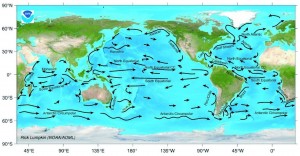Main ocean currents
To the 5 subtropical gyres correspond 5 major western boundary currents:
The Gulf Stream – In the North Atlantic, the resonance of Rossby waves occurs off the Cape Hatteras where two major currents collide, the cold Labrador Current flowing south and the warm Florida Current flowing north, the Gulf Stream. The quasi-stationary wave extends eastward along the gyre, then takes the direction of northeast to merge with the North Atlantic drift and spreads to the north while vanishing.
The Brazil current – In the South Atlantic, the resonance of Rossby waves occurs off the mouth of the Río de la Plata in Argentina, where two powerful currents collide in the Zone of Confluence, the cold Malvinas current flowing north and the warm current of Brazil. The wave is divided into two branches at 40°S and 50°S.
The Kuroshio Current – In the North Pacific, the resonance occurs off the eastern coast of Japan where two currents collide, the cold Oyashio current flowing south-west and the warm Kuroshio Current flowing north-east. The main antinode extends eastward between 30°N and 40°N latitude.
The western boundary currents of the subtropical gyre of the South Pacific – The resonance occurs near the eastern coast of Australia, where the Eastern Australian Current, the most powerful current near Australia, leaves the coast. The quasi-stationary wave extends eastward, following the Eastern Australian Current between 25°S and 30°S, then towards the southeast beyond 130°W until it meets the west coast of South America. Another resonance occurs off the east coast of New Zealand, the wave propagating towards the southeast at latitude 40°S in the vicinity of New Zealand, then at 60°S south of the Cape Horn. It merges with the Antarctic Circumpolar Current south of 50°S.
The Agulhas – South of the Indian Ocean, the resonance occurs off the southern tip of the African continental shelf, 40°S. The Agulhas indeed follows the continental shelf in its southern part, then turns back when it meets the Benguela current flowing north along the west coast of South Africa. The quasi-stationary wave propagates towards the southeast and merges with the Antarctic Circumpolar Current south of 50°S, then, in the absence of continent, it forms a ring when it merges with the waves issuing from the other gyres of the southern hemisphere.
Glossary
Western boundary currents. Western boundary currents, warm, deep, narrow and fast are formed along the western boundary of the ocean. They carry warm water from the tropics to the poles, forming the western branch of the subtropical gyres. It is the Gulf Stream (North Atlantic), the Brazil Current (South Atlantic) the Agulhas (South Indian Ocean), the Kuroshio (North Pacific), and the western boundary currents of the subtropical gyre in the South Pacific.
